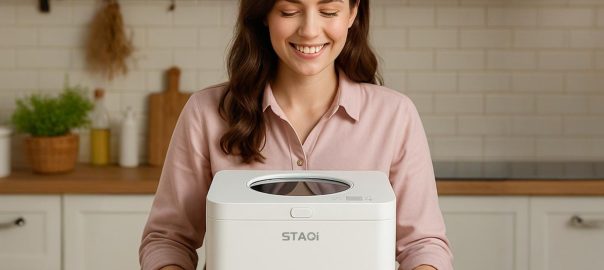Stagi helps you easily compost and create your ideal garden!


What is Composting?
Composting is the process of creating fertilizer by piling organic materials and returning them to the soil. It accelerates the transformation of common organic waste—such as kitchen scraps, rice bran, rice husks, dead leaves, cardboard, and animal manure—into nutrient-rich humus through microbial digestion (fermentation). For example, forgotten kitchen waste may emit a sour odor after three days of natural fermentation, while fallen leaves in forests slowly turn into humus-rich soil over time. Composting is essentially a collaborative partnership with microorganisms that feed on organic matter.
Benefits of Composting
For urban gardeners, compost provides essential nutrients for healthy plant growth. Most daily kitchen waste can serve as raw material for composting. Instead of discarding these scraps as unknown waste, we can personally close the ecological loop: repurposing kitchen waste into compost reduces overall garbage production.
Composting Principles and Materials Composting fundamentally leverages EM microbial inoculants to achieve rapid decomposition through intermittent anaerobic fermentation. Acceptable Materials: Kitchen scraps (vegetable peels, bean hulls, okara) Nut shells, eggshells, coffee grounds Leaves, shredded branches/straw Crushed pork/chicken bones Prohibited Materials: ✗ Pest-infected or diseased plants ✗ Invasive weeds ✗ Grass seeds/turf ✗ Meat or dairy products ✗ Carnivore feces (e.g., dog/cat) ✗ Evergreen conifer needles/leaves Composting Procedure Base layer: Line the bin bottom with vegetable leaves Preprocessing: Pulverize scraps using a compost accelerator Stratification: Alternate kitchen waste and fermented grain bran in sandwich-style layers Leachate management: Drain liquid fertilizer weekly to prevent microbial suffocation Progress monitoring: Inspect hyphae development at Week 2 Completion achieved in 4–6 weeks
Composting Principles and Materials
Composting fundamentally leverages EM microbial inoculants to achieve rapid decomposition through intermittent anaerobic fermentation.
Acceptable Materials:
Kitchen scraps (vegetable peels, bean hulls, okara)
Nut shells, eggshells, coffee grounds
Leaves, shredded branches/straw
Crushed pork/chicken bones
Prohibited Materials:
✗ Pest-infected or diseased plants
✗ Invasive weeds
✗ Grass seeds/turf
✗ Meat or dairy products
✗ Carnivore feces (e.g., dog/cat)
✗ Evergreen conifer needles/leaves
Composting Procedure
Base layer: Line the bin bottom with vegetable leaves
Preprocessing: Pulverize scraps using a compost accelerator
Stratification: Alternate kitchen waste and fermented grain bran in sandwich-style layers
Leachate management: Drain liquid fertilizer weekly to prevent microbial suffocation
Progress monitoring:
Inspect hyphae development at Week 2
Completion achieved in 4–6 weeks


